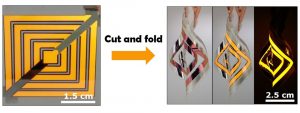Organic light emitting diodes (OLEDs) offer a range of new opportunities for lighting design due to their flexible, thin film form factor. These devices have already demonstrated efficient generation of high-quality white light and are in the early stages of commercialization; however, efforts to exploit their flexibility and set them apart from inorganic LEDs in the marketplace are still just beginning.
Researchers from the Gieblink Research Group at Penn State University have now introduced a new opportunity for creative OLED lighting design by cutting and folding thin OLED films into a variety of three-dimensional shapes using ideas related to kirigami, the Japanese art of paper cutting and folding. The researchers have demonstrated large area light emitting diodes encapsulated between ultrathin plastic films that can be cut and folded in much the same way as paper. Then this capability was used together with Kirigami techniques to create three-dimensional OLEDs ranging from a light emitting globe to a wispy candle flame to showcase this new artistic opportunity for lighting design.

A flat thin film organic light emitting diode (left) is cut and folded using a Kirigami-based design to mimic a candle flame in three dimensions (right).
This work opens up a creative new pathway to leverage the flexibility of OLEDs for distinctive lighting design that is not possible with inorganic LEDs. Also, it suggests a future in which consumers can buy OLED sheets like paper and then cut, fold, and assemble their own 3D lighting creations.
For more information, please find here the full manuscript.

















